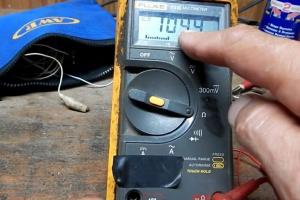Mastering Potentiometer Testing: A Comprehensive Guide

-
Quick Links:
- Introduction
- Understanding Potentiometers
- Tools Required for Testing
- Step-by-Step Guide to Testing a Potentiometer
- Troubleshooting Common Issues
- Case Studies and Examples
- Expert Insights
- Conclusion
- FAQs
Introduction
Potentiometers are crucial components in various electronic devices, serving as variable resistors and voltage dividers. Whether you’re an electronics enthusiast or a seasoned engineer, knowing how to test potentiometers is essential for maintaining and troubleshooting circuits. This comprehensive guide will walk you through the methods, tools, and best practices for testing potentiometers effectively.
Understanding Potentiometers
A potentiometer, often referred to as a "pot," is a three-terminal resistor with a sliding contact that allows for the adjustment of resistance. It is widely used in applications such as volume controls, light dimmers, and tuning circuits.
- Types of Potentiometers:
- Linear Potentiometers
- Rotary Potentiometers
- Digital Potentiometers
- Applications:
- Adjustable gain in amplifiers
- Volume control in audio devices
- Position sensing in robotics
Tools Required for Testing
Before diving into testing, ensure you have the following tools on hand:
- Multimeter (analog or digital)
- Screwdriver set (for accessing potentiometers in devices)
- Wire cutters/strippers
- Soldering iron (if replacement is necessary)
- Test leads
Step-by-Step Guide to Testing a Potentiometer
Testing a potentiometer involves measuring its resistance and ensuring it functions correctly throughout its range. Follow these steps:
Step 1: Safety First
Before testing, ensure all power to the circuit is turned off to prevent electric shock or damage to your multimeter.
Step 2: Identify the Potentiometer
Locate the potentiometer in your circuit. Note its pin configuration, typically labeled as A (start), B (end), and W (wiper).
Step 3: Set Up Your Multimeter
Set your multimeter to the resistance (Ω) setting. If it’s an analog meter, adjust it to a suitable range.
Step 4: Measure Resistance
To measure the total resistance:
- Connect one probe to terminal A and the other to terminal B. This measures the full resistance of the potentiometer.
To measure the wiper resistance:
- Connect one probe to terminal W and the other to terminal A, then repeat the process for terminal W to terminal B.
Step 5: Analyze Results
Compare your readings against the potentiometer’s rated resistance. A significant deviation may indicate a fault.
Troubleshooting Common Issues
If your tests indicate problems, consider the following troubleshooting steps:
- No resistance reading: This could indicate a broken element within the pot.
- Inconsistent readings: This may suggest dirt or oxidation on the wiper contact. Cleaning may resolve the issue.
- Physical damage: Inspect for cracks or breaks; consider replacement if damaged.
Case Studies and Examples
Here are a couple of real-world scenarios where testing a potentiometer made a significant difference:
Case Study 1: Audio Equipment Malfunction
An audio technician was called to fix a mixer that had inconsistent volume levels. After testing the potentiometers, he discovered that one was faulty, leading to a simple yet effective replacement that restored functionality.
Case Study 2: Robotics Calibration
A robotics engineer faced issues with a robot's movement precision. Testing the potentiometers that controlled the servos revealed a faulty unit, which, once replaced, improved the robot's performance significantly.
Expert Insights
We consulted with leading electrical engineers and technicians to provide you with expert tips on potentiometer testing:
- Always keep your testing environment clean to prevent debris from affecting readings.
- Consider using contact cleaner for pots that exhibit inconsistent behavior.
- Regularly test potentiometers in critical applications to prevent unexpected failures.
Conclusion
Testing a potentiometer is a straightforward yet essential skill in electronics. By following the steps outlined in this guide, you can ensure your circuits function correctly and efficiently. Remember to utilize the right tools, analyze your readings critically, and don’t hesitate to seek expert advice when necessary.
FAQs
- What is a potentiometer? A potentiometer is a three-terminal resistor that allows for the adjustment of resistance and voltage in a circuit.
- How do I know if my potentiometer is faulty? You can test it with a multimeter. If it shows inconsistent or no readings, it may be faulty.
- Can I repair a potentiometer? In some cases, cleaning the contacts can restore functionality, but often replacement is the best option.
- What types of potentiometers are there? The main types include linear, rotary, and digital potentiometers.
- How do I clean a potentiometer? Use a contact cleaner spray and a soft cloth to remove dirt and oxidation.
- Are all potentiometers the same? No, they vary in resistance value, taper (linear or logarithmic), and physical size.
- What applications use potentiometers? They are used in audio equipment, lighting controls, and various electronic devices.
- What is the difference between a potentiometer and a rheostat? A rheostat is a type of potentiometer specifically designed for high current applications.
- How often should I test potentiometers? Regular testing is recommended, especially in critical applications where performance is vital.
- Can I test a potentiometer in-circuit? Yes, but ensure that other components do not affect your measurements.
Random Reads
- How to install a floating floor
- How to install a gas dryer
- How to make an international call to mexico
- How to make dragon armor in skyrim
- How to make dmg file mac
- How to make computer operating system
- How to build shelves
- How to build stairs
- Easy ways to view airtel data usage
- Easy ways to use usb flash drive